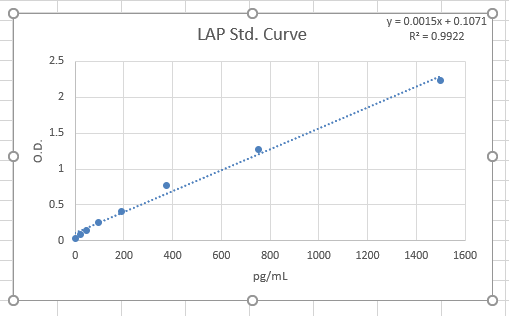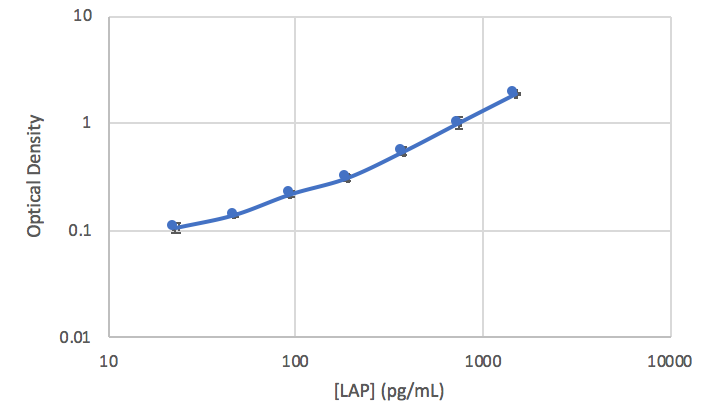Human LAP (TGF-beta 1) Quantikine ELISA Kit Summary
Product Summary
Precision
Cell Culture Supernates, Cell Lysates, Serum, Platelet-poor EDTA Plasma, Platelet-poor Heparin Plasma, Urine
| Intra-Assay Precision | Inter-Assay Precision | |||||
|---|---|---|---|---|---|---|
| Sample | 1 | 2 | 3 | 1 | 2 | 3 |
| n | 20 | 20 | 20 | 20 | 20 | 20 |
| Mean (pg/mL) | 218 | 427 | 992 | 216 | 460 | 1126 |
| Standard Deviation | 6.92 | 17.7 | 42.1 | 7.68 | 21.7 | 86.9 |
| CV% | 3.2 | 4.1 | 4.2 | 3.6 | 4.7 | 7.7 |
Recovery
The recovery of LAP (TGF-beta 1) spiked to levels throughout the range of the assay followed by activation was evaluated.
| Sample Type | Average % Recovery | Range % |
|---|---|---|
| Cell Culture Supernates (n=4) | 98 | 90-105 |
| Cell Lysates (n=4) | 97 | 90-103 |
| Urine (n=4) | 95 | 87-101 |
Linearity
Scientific Data
Product Datasheets
Preparation and Storage
Background: LAP (TGF-beta 1)
TGF- beta 1 (Transforming Growth Factor beta 1) and the closely related TGF-beta 2 and -beta 3 are members of the large TGF-beta superfamily. TGF beta proteins are highly pleiotropic cytokines with distinct, but overlapping, activities regulating processes such as immune function, proliferation, and epithelial mesenchymal transition (1-3). Almost all cells can produce TGF-beta 1, and a particularly high concentration is found in platelets (1-4). Human TGF-beta 1 cDNA encodes a 390 amino acid (aa) precursor that contains a 29 aa signal peptide and a 361 aa proprotein (2). A furin-like convertase processes the proprotein within the trans-Golgi to generate an N-terminal 249 aa latency-associated peptide (LAP) and a C-terminal 112 aa mature TGF- beta 1 (2, 3, 5). Disulfide-linked homodimers of LAP and TGF-beta 1 remain non-covalently associated after secretion, forming the inactive small latent TGF-beta 1 complex (5-12). Covalent linkage of LAP to one of three latent TGF-beta binding proteins (LTBPs) creates a large latent complex that may interact with the extracellular matrix (3, 5-7, 13). TGF-beta activation from latency is controlled both spatially and temporally by multiple pathways that may include the actions of proteases such as plasmin, MMP-2 or MMP-9, adhesion through integrins such as alpha v beta 6 and alpha v beta 8, and/or interaction with Thrombospondin-1 (3, 5, 7, 12-14).
Citations for Human LAP (TGF-beta 1) Quantikine ELISA Kit
R&D Systems personnel manually curate a database that contains references using R&D Systems products. The data collected includes not only links to publications in PubMed, but also provides information about sample types, species, and experimental conditions.
6
Citations: Showing 1 - 6
Filter your results:
Filter by:
-
The TGF? type I receptor kinase inhibitor vactosertib in combination with pomalidomide in relapsed/refractory multiple myeloma: a phase 1b trial
Authors: Malek, E;Rana, PS;Swamydas, M;Daunov, M;Miyagi, M;Murphy, E;Ignatz-Hoover, JJ;Metheny, L;Kim, SJ;Driscoll, JJ;
Nature communications
Species: Human
Sample Types: Cell Culture Supernates
-
Effect of magnetic microbeads on sustained and targeted delivery of transforming growth factor-beta-1 for rotator cuff healing in a rat rotator cuff repair model
Authors: Lee, J;Park, J;Chang, Y;Yoon, JP;Chung, SW;
Scientific reports
Species: Human
Sample Types: Protein
-
Bone marrow mesenchymal stem cells paracrine TGF-beta1 to mediate the biological activity of osteoblasts in bone repair
Authors: X Zhang, G Wang, W Wang, C Ran, F Piao, Z Ma, Z Zhang, G Zheng, F Cao, H Xie, D Cui, C Samuel Oko, X Yu, Z Wang, D Zhao
Cytokine, 2023-02-02;164(0):156139.
Species: Human
Sample Types: Cell Culture Supernates
-
The histone demethylase PHF8 regulates TGFbeta signaling and promotes melanoma metastasis
Authors: RS Moubarak, A de Pablos-, V Ortiz-Bara, Y Gong, M Gowen, I Dolgalev, SAA Shadaloey, D Argibay, A Karz, R Von Itter, EC Vega-Sáenz, E Sokolova, F Darvishian, A Tsirigos, I Osman, E Hernando
Science Advances, 2022-02-18;8(7):eabi7127.
Species: Human
Sample Types: Cell Culture Supernates
-
Characteristics of autologous protein solution and leucocyte-poor platelet-rich plasma for the treatment of osteoarthritis of the knee
Authors: S Wasai, M Sato, M Maehara, E Toyoda, R Uchiyama, T Takahashi, E Okada, Y Iwasaki, S Suzuki, M Watanabe
Sci Rep, 2020;10(1):10572.
Species: Human
Sample Types: Plasma
-
Effects of pirfenidone targeting the tumor microenvironment and tumor-stroma interaction as a novel treatment for non-small cell lung cancer
Authors: A Fujiwara, S Funaki, E Fukui, K Kimura, T Kanou, N Ose, M Minami, Y Shintani
Sci Rep, 2020;10(1):10900.
Species: Human
Sample Types: Cell Culture Supernates
FAQs
No product specific FAQs exist for this product, however you may
View all ELISA FAQsReviews for Human LAP (TGF-beta 1) Quantikine ELISA Kit
Average Rating: 4.7 (Based on 3 Reviews)
Have you used Human LAP (TGF-beta 1) Quantikine ELISA Kit?
Submit a review and receive an Amazon gift card.
$25/€18/£15/$25CAN/¥75 Yuan/¥2500 Yen for a review with an image
$10/€7/£6/$10 CAD/¥70 Yuan/¥1110 Yen for a review without an image
Filter by:






